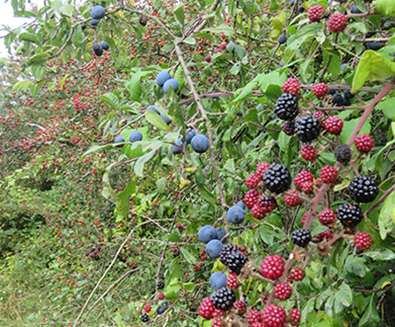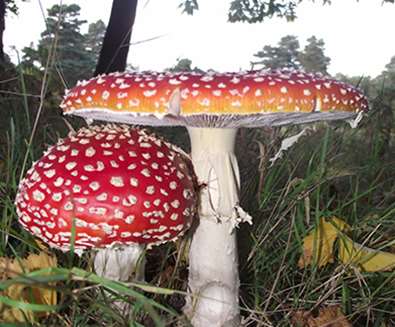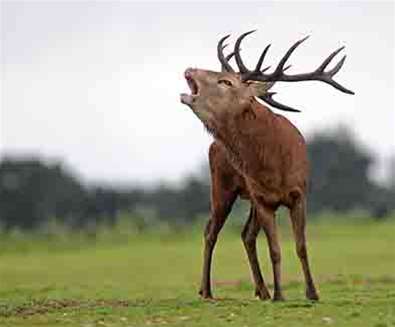Are you are fungi at a stag do? Then a visit to RSPB Minsmere nature reserve could be just up your street. Visitor Experience Officer Ian Barthorpe tells us what you can expect to see this autumn...
Whether you’re an enthusiastic birdwatcher, aspiring artist, intrepid walker or fun-loving family there’s something to suit all tastes and experiences at RSPB Minsmere in autumn,
For many people, autumn conjures up pictures of a changing landscape as green turns to brown and gold and red, and nature prepares to sleep for the winter, but that only tells part of the story. Yes, it’s a time of change, but it’s a time of new life as well as old.
Woodland trees change, in turn, from the deep green of late summer, through various hues of brown and gold. The last to turn, the majestic old oaks, may remain green as late as December. The change is most noticeable in hedgerows as birch, field maple and dogwood slowly lose their leaves, while rich purple sloes and blackberries, deep red hawthorn berries and vibrant rosehips and honeysuckles drip, invitingly, from the bushes.

This is a time of plenty, and wildlife is capitalising on it. Warblers and chats are refuelling prior to their long migration south to Africa, while newly arrived robins, thrushes and blackbirds take advantage of the rich sugary berries after crossing the North Sea from Scandinavia. Mice and voles, too, are busy feeding on these berries, building up their fat resources for the long winter ahead.
It's not just berries that provide food for small mammals. Many are partial to foraging for fungi, including species that can be poisonous to us. Some of the fungi are big, bold and easy to spot, such as the dinner-plate-sized parasol mushrooms and oak polypore that cling like shelf brackets to tree trunks – hence the term bracket fungi.
Others can be harder to spot among the leaf litter, but it’s well worth searching for the tiny amethyst deceiver or the aptly named porcelain fungus that looks like a piece of fine crockery.
One of the most familiar fungi is the fly agaric, made famous by many a children’s fairytale with its white spotted red cap. You can often find several of these distinctive toadstools beneath birch trees. You’ll need to be very lucky to spot the elves and fairies that live among them, though, as they only show themselves to the chosen few!

Fly agaric, like many fungi, is mildly hallucinogenic, but some species, such as the death cap, are highly poisonous and should not be touched.
Your nose may point you in the direction of some wildlife too. The foul-smelling stinkhorn is a common fungi in the woods, and the musty smell of a dog fox often lingers long after the animal has passed. Autumn is a good time to see evidence of foxes with their blackberry seed-filled droppings often found alongside the path.
Other mammals, too, are easier to locate by their droppings and other signs than by actually spotting them. A good example is Minsmere’s badgers that have a very obvious latrine (toilet) in the woods. Otters, too, leave distinctive droppings, known as spraints. If you are very lucky, you may even spot an otter at Island Mere. Early winter mornings are good times to look.
One mammal, though, is easy to spot at Minsmere in autumn, and that’s the red deer. We have one of the largest herds in England, and right now they’re rutting on Minsmere’s heaths, making them both easier to see and hear.
The rut is one of nature’s greatest spectacles as huge stags bellow and posture to assert their authority over rivals and win the right to mate with as large a harem of hinds as possible. When this posturing isn’t enough they may lock antlers in a real show of strength, but such fights are surprisingly rare.
If you want to see this spectacle for yourself, head to Minsmere during October. The best of the action is around dawn and dusk south of the footpath along the southern edge of Westleton Heath, from where the deer will likely be about 400 metres away. Pop into the visitor centre first and we’ll give you a map and directions.

Of course, you may want to pop into the café first, too, to refuel on your own sugary (or savoury) treat. Our cheese scones are famous across Suffolk, and there’s an excellent choice of delicious cakes, including several that are gluten-free. The café also serves a range of home-cooked food, much of it made using locally-sourced produce, including various vegetarian and vegan options.
The shop, too, is worth a visit, giving you the chance to buy field guides, binoculars, gifts or Christmas cards (sorry, is it too early to mention them?)
There’s plenty of birds to see around the reserve’s nature trails this autumn too. Spend time in the spacious birdwatching hides overlooking the famous Scrape (a shallow, man-made lagoon) and you’ll see hundreds of teals, gadwalls, wigeons and other ducks that are visiting for the winter, as well as snipe and black-tailed godwits probing into the soft mud with their incredibly long bills.
The reedbed wildlife is typically more elusive, but with a bit of luck or patience (or both!) you may spot an otter, bittern, bearded tit or kingfisher, as a marsh harrier glides effortlessly overhead.
Stay on the reserve until dusk and you may even be lucky enough to watch another great natural spectacle as thousands of starlings swirl above the reeds before settling to roost. The timing of this spectacle is, however, unpredictable. Sometimes they are best seen in autumn, but in recent years it’s been better in late winter. Please check our Facebook and Twitter pages for the latest news.
If you’ve been to Minsmere before, you’ll know what an amazing place it is – I am so lucky to work here every day. If you’ve not been to see us yet, then why not plan your first visit soon. We’re open every day, so there’s no excuse.
For full details about visiting Minsmere see www.rspb.org.uk/minsmere. You can keep up to date with news from Minsmere on Twitter @RSPBMinsmere or Facebook at RSPBSuffolk.